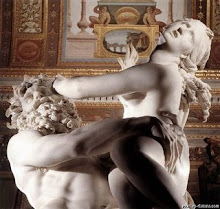skip to main |
skip to sidebar



















 JORDAENS, Jacob
JORDAENS, Jacob
(b. 1593, Antwerpen, d. 1678, Antwerpen)
Biography
Flemish painter, the pupil and son-in-law of Adam van Noort. Although Jordaens often assisted Rubens, he had a flourishing studio of his own by the 1620s, and after Rubens's death in 1640 he was the leading figure painter in Flanders. His style was heavily indebted to Rubens, but was much more earthbound, using thick impasto, strong contrasts of light and shade, and colouring that is often rather lurid. His physical types, too, are coarser than Rubens's and his name is particularly associated with large canvases of hearty rollicking peasants. Two of his favourite subjects, which he depicted several times are The Satyr and the Peasant, based on one of Aesop's fables, and The King Drinks, which depicts a boisterous group enjoying an abundant Twelfth Night feast. Jordaens's prolific output, however, included many other subjects, including religious works and portraits, and he also etched and made designs for tapestries.
He rarely left his native Antwerp, but commissions came from all over Europe, the most important being The Triumph of Frederick Hendrik (1651-2), an enormous composition painted for the Huis ten Bosch, the royal villa near The Hague. In about 1655 Jordaens became a Calvinist; he continued to paint pictures for Catholic churches, but the work of the last two decades of his life is more subdued.




















 RENI, Guido
RENI, Guido
(b. 1575, Calvenzano, d. 1642, Bologna)
Biography
Italian painter of popular religious works and critically acclaimed mythological scenes. He was born in Bologna and began to study painting at the age of nine; he joined the Carracci Academy when he was 20. His studies were rounded off by a trip to Rome in about 1600. From that moment on, antique and recent Roman art became his ideals. He admired Raphael unconditionally. He did, however, come to terms with Caravaggio's naturalism in a group of youthful works such as The Crucifixion of St Peter in the Vatican Gallery (1604), where the use of chiaroscuro provided enormous energy.
He alternated between living in his native Bologna and visits to Rome. After Annibale Carracci's death (1609) he became the leader of the classical school of Emilian painters. His adhesion to this school can be seen in the frescos he painted in Rome in about 1610 in the Quirinal Palace, the Vatican, and various churches (e.g. San Gregorio Magno al Cielo). They were inspired by the return to classical taste and culminated in Aurora in Palazzo Ludovisi which has almost mimetic qualities. The large altarpieces he painted in Bologna - The Massacre of the Innocents and Pietà dei Mendicanti both in the Bologna Pinacoteca Nazionale - mark the triumph of design, the ability to control and channel feelings, gestures, expressions, drawing, and colour into a single, eloquent, and faultless form. Guido Reni's success was underlined by the important commissions he received. They included the cycle of The Labors of Hercules (1617-21) that he painted for the Duke of Mantua and which are now in the Louvre. He exalted the clarity of light, the perfection of the body, and lively colour. Toward the end of his life, Reni modified his style. His paintings became so airy as to seem insubstantial and were almost completely monochrome. He also used long, flowing brushstrokes and conveyed an atmosphere laden with intense melancholy.
Guido Reni was a quintessentially classical academic but he was also one of the most elegant painters in the annals of art history. He was constantly seeking an absolute, rarefied perfection which he measured against classical Antiquity and Raphael. Because of this, over the years the Bolognese painter has been in and out of fashion, depending on the tastes of the times. The eighteenth century loved him, the nineteenth century, persuaded by the violent criticism of John Ruskin, hated him. But even his detractors cannot deny the exceptional technical quality of his work nor the clarity of his supremely assured and harmonious brushwork.



 PADOVANINO
PADOVANINO
(b. 1588, Padova, d. 1649, Venezia)
Biography
Italian painter, originally Alessandro Varotari. He was the son of Dario Varotari (d. 1598), a painter and architect, pupil of Veronese, and of Samaritana, the daughter of Giovan Battista Ponchino. The family is of German origin (Weyrother).
His earliest training is unknown, though Boschini (1674) stated that Padovanino studied by copying the frescoes of Titian in the Scuola di S Antonio, Padua, and other works by the master, above all those of his youth or his early maturity. The influence of Titian remained fundamental to Padovanino's art. The Incredulity of St Thomas (1610; Padua, S Lucia) is his first dated work and faithfully imitates that of Titian; other youthful works are direct copies, among them The Pentecost (Venice, Accademia) and the Virgin and Child (Padua, Cathedral).
He moved to Venice in 1614 and settled there until his death thirty-five years later. Though today he is principally thought of as a follower of Titian, and indeed he is known to have painted a number of copies after the master's works, Padovanino was a talented and successful painter in his own right. He went on at least two visits to Rome (in the mid-1610s and again in 1625), during which he was able to study the works of Michelangelo and Annibale Carracci, but Palma Giovane and of course Titian remained the over-riding influences in his work.









































































.jpg)
















